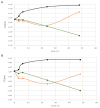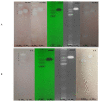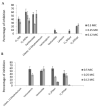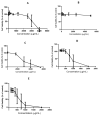Chicory Extracts and Sesquiterpene Lactones Show Potent Activity against Bacterial and Fungal Pathogens
- PMID: 34577641
- PMCID: PMC8469098
- DOI: 10.3390/ph14090941
Chicory Extracts and Sesquiterpene Lactones Show Potent Activity against Bacterial and Fungal Pathogens
Abstract
Chicory (Cichorium intybus L.) is an important industrial crop cultivated mainly to extract the dietary fiber inulin. However, chicory also contains bioactive compounds such as sesquiterpene lactones and certain polyphenols, which are currently discarded as waste. Plants are an important source of active pharmaceutical ingredients, including novel antimicrobials that are urgently needed due to the global spread of drug-resistant bacteria and fungi. Here, we tested different extracts of chicory for a range of bioactivities, including antimicrobial, antifungal and cytotoxicity assays. Antibacterial and antifungal activities were generally more potent in ethyl acetate extracts compared to water extracts, whereas supercritical fluid extracts showed the broadest range of bioactivities in our assays. Remarkably, the chicory supercritical fluid extract and a purified fraction thereof inhibited both methicillin-resistant Staphylococcus aureus (MRSA) and ampicillin-resistant Pseudomonas aeruginosa IBRS P001. Chicory extracts also showed higher antibiofilm activity against the yeast Candida albicans than standard sesquiterpene lactone compounds. The cytotoxicity of the extracts was generally low. Our results may thus lead to the development of novel antibacterial and antifungal preparations that are both effective and safe for human use.
Keywords: antifungal; antimicrobial; bioactivity; biofilm; chicory; cytotoxicity.
Conflict of interest statement
The authors declare no conflict of interest. The funders had no role in the design of the study; in the collection, analyses, or interpretation of data; in the writing of the manuscript; or in the decision to publish the results.
Figures





Similar articles
-
Anthelmintic and metabolomic analyses of chicory (Cichorium intybus) identify an industrial by-product with potent in vitro antinematodal activity.Vet Parasitol. 2020 Apr;280:109088. doi: 10.1016/j.vetpar.2020.109088. Epub 2020 Mar 18. Vet Parasitol. 2020. PMID: 32278938
-
Supercritical CO2 Extraction as a Tool to Isolate Anti-Inflammatory Sesquiterpene Lactones from Cichorium intybus L. Roots.Molecules. 2021 Apr 28;26(9):2583. doi: 10.3390/molecules26092583. Molecules. 2021. PMID: 33925241 Free PMC article.
-
In vitro analysis of the anthelmintic activity of forage chicory (Cichorium intybus L.) sesquiterpene lactones against a predominantly Haemonchus contortus egg population.Vet Parasitol. 2011 Aug 25;180(3-4):298-306. doi: 10.1016/j.vetpar.2011.03.013. Epub 2011 Mar 17. Vet Parasitol. 2011. PMID: 21477927
-
Chicory (Cichorium intybus L.) as a food ingredient - Nutritional composition, bioactivity, safety, and health claims: A review.Food Chem. 2021 Jan 30;336:127676. doi: 10.1016/j.foodchem.2020.127676. Epub 2020 Jul 29. Food Chem. 2021. PMID: 32768902 Review.
-
Antiparasitic activity of chicory (Cichorium intybus) and its natural bioactive compounds in livestock: a review.Parasit Vectors. 2018 Aug 22;11(1):475. doi: 10.1186/s13071-018-3012-4. Parasit Vectors. 2018. PMID: 30134991 Free PMC article. Review.
Cited by
-
Structure-dependent activity of plant natural products against methicillin-resistant Staphylococcus aureus.Front Microbiol. 2023 Aug 15;14:1234115. doi: 10.3389/fmicb.2023.1234115. eCollection 2023. Front Microbiol. 2023. PMID: 37649631 Free PMC article. Review.
-
Polyphenols as Inhibitors of Antibiotic Resistant Bacteria-Mechanisms Underlying Rutin Interference with Bacterial Virulence.Pharmaceuticals (Basel). 2022 Mar 21;15(3):385. doi: 10.3390/ph15030385. Pharmaceuticals (Basel). 2022. PMID: 35337182 Free PMC article.
-
A simple thin-layer chromatography autography for the detection of peroxidase inhibitors.J Food Sci Technol. 2024 Sep;61(9):1722-1732. doi: 10.1007/s13197-024-05946-w. Epub 2024 Mar 2. J Food Sci Technol. 2024. PMID: 39049920
-
Lactucin Synthase Inactivation Boosts the Accumulation of Anti-inflammatory 8-Deoxylactucin and Its Derivatives in Chicory (Cichorium intybus L.).J Agric Food Chem. 2023 Apr 10;71(15):6061-72. doi: 10.1021/acs.jafc.2c08959. Online ahead of print. J Agric Food Chem. 2023. PMID: 37036799 Free PMC article.
-
Antimicrobial Activity of Lactones.Antibiotics (Basel). 2022 Sep 29;11(10):1327. doi: 10.3390/antibiotics11101327. Antibiotics (Basel). 2022. PMID: 36289985 Free PMC article. Review.
References
-
- Van Arkel J. Ph.D. Thesis. Wageningen University; Wageningen, The Netherlands: 2013. Fructan Biosynthesis in Crop Plants, The Molecular Regulation of Fructan Biosynthesis in Chicory (Cichorium Intybus L.)
-
- Cankar K., Bundock P., Sevenier R., Häkkinen S.T., Hakkert J.C., Beekwilder J., Meer I.M., Both M., Bosch D. Inactivation of the Germacrene A Synthase Genes by CRISPR/Cas9 Eliminates the Biosynthesis of Sesquiterpene Lactones in Cichorium Intybus L. Plant Biotechnol. J. 2021:13670. doi: 10.1111/pbi.13670. - DOI - PMC - PubMed
Grants and funding
LinkOut - more resources
Full Text Sources
Molecular Biology Databases

